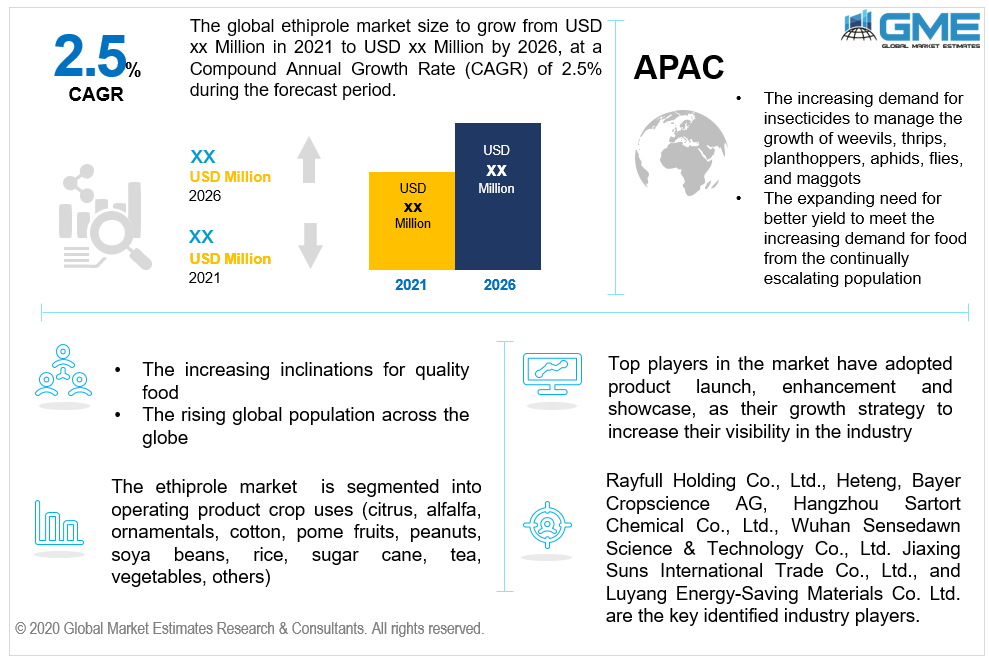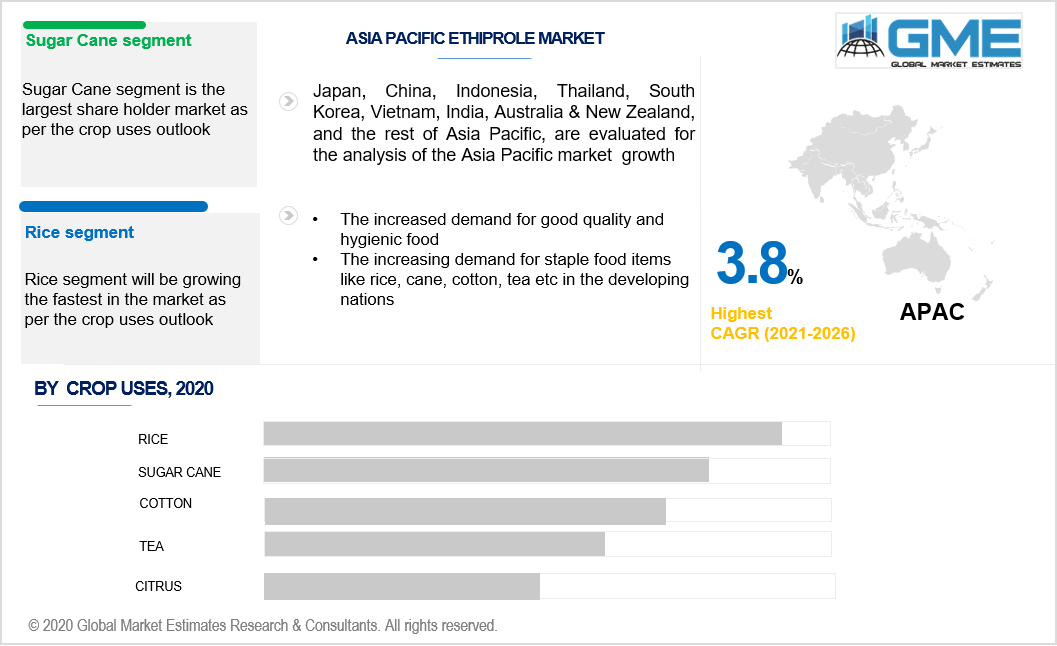
Global Ethiprole Market Size, Trends & Analysis - Forecasts to 2026 By Crop Uses (Citrus, Alfalfa, Ornamentals, Cotton, Pome Fruits, Peanuts, Soya Beans, Rice, Sugar Cane, Tea, Vegetables, Others), By Region (North America, Asia Pacific, Europe, Latin America, Middle East & Africa); End-User Landscape, Company Market Share Analysis, and Competitor Analysis
Insecticides are substances used for the termination of insects harming the fruit trees and crops. Insecticides are used primarily for agricultural use to lessen the influence of insects, which are mainly responsible for diminishing the productivity of crops. Ethiprole relates to the chemical family of phenylpyrazole. This insecticide is known to affect the insects and kill them by attacking their CNS and obstructing their glutamate-gated chloride channel. This then causes a poisonous reaction in the insects and leads their body to apoptosis, hence making ethiproleone of the most efficient products in the market. Its usage in agriculture majorly dominates the demand for ethiprole. Developed regions dominate the market for insecticides in general. Hence, with the rising need for better crop yield, the Asia Pacific market will grow rapidly during the forecast period.
In 1994, Bayer CropScience Ltd. had produced Ethiprole. Ethiprole is now used in cotton, rice crops, tea, soybeans, and other vegetables directly and for warehousing wheat, corn pome, peanuts, and other citrus fruits from numerous insects attacking them. Its usage further enhances the ability of ethiprole along with other insecticides. Presently, ethiprole is an effective insecticide for managing thrips, planthoppers, weevils, aphids, maggots, flies, grasshoppers, leaf miners, phyllids, and whiteflies. Ethiprole presents excellent resistance to rice crops facing stink bugs making ethiprole extremely suitable for rice crops. However, no reliable data concerning the carcinogenetic effect is available of ethiprole. Moreover, the substantial ability to manage insects makes the market for ethiprole profitable for several insecticide manufacturing companies. Hence, the global ethiprole market will grow significantly in the forecast period.
The agriculture sector is the largest end-use industry where ethiprole is anticipated to emerge as the best insecticide for crop varieties. The increasing inclinations for quality food coupled with rigorous food regulations by the United States Food and Drug Administration (FDA) and Registration, Evaluation, Authorisation, and Restriction of Chemicals (REACH) is anticipated to affect the global market directly. Consequently, the global ethiprole market will grow considerably over the forecast period.
Besides, ethiprole can also be combined with other insecticides resulting in a highly effective insecticide that almost doubles the control over insects in the products. This will propel the market growth for ethiprole over the forecast period.

By crop uses, there are twelve segments: citrus, alfalfa, ornamentals, cotton, pome fruits, peanuts, soya beans, rice, sugar cane, tea, vegetables, and others.The largest crop use segment for ethiprole is rice crops. Most economies heavily dependent on rice crops for consumption. Rice is a staple food for more than 3.5 billion individuals worldwide, particularly in Latin America, Asia, and parts of Africa. Asia is the homeland for growing rice for many decades. Being a staple food for many, protecting these rice crops is most important. Thus, this factor will accelerate the market growth for ethiprole over the forecast period.
The use of ethiprole in sugarcane is another major downstream based on the consumption level of sugarcane. Sugarcane is a crop fundamentally grown in tropical countries and has the outstanding quality of serving as both a fuel source and food. Along with supplying 86 percent ofthe world’s sugar, the remaining comes from beet,sugarcane also works as a principal biofuel feedstock. It is extremely efficient in turning sunlight into energy. The food manufacturing industry consumes seventy-five percent of the sugarcane produced worldwide, and the remaining is utilized in biofuel production.

As per the geographical analysis, the market can be classified into North America (the United States, Canada, and Mexico), Asia Pacific (India, China, Japan, Malaysia, Singapore, and Rest of Asia Pacific), Europe (Germany, United Kingdom, Italy, France, Spain, Netherlands, and Rest of Europe), Middle East & Africa (Saudi Arabia, United Arab Emirates, and Rest of the Middle East & Africa) and Central South America (Brazil, Argentina, and Rest of Central and South America).The Asia Pacific region is foreseen to be the fastest-growing market for ethiprole in the forecast period. The main reason for this is the increasing demand for insecticides to manage the growth of weevils, thrips, planthoppers, aphids, flies, and maggots in China and India owing to the expanding need for better yield to meet the increasing demand for food from the continually escalating population. Moreover, developed countries are concentrating on achieving maximum agricultural output from the present arable land. Hence, these factors will lead to positive growth of the market during the forecast period.The growing population with the increased demand for good quality and hygienic food is anticipated to propel the market growth for ethiprole in the Asia Pacific region.
Most companies are operating in the Asia Pacific region due to enormous consumer demand along with increasing agricultural activities and cheap labor. Companies are expected to concentrate on developing economies to improve their volume and market share by product innovation, business expansion, establishing new manufacturing units on-demand basis across the region, enhancing their research and development activities, enhancing product quality, opting for different strategies such as mergers, joint ventures, and collaborations with other manufacturers.
Ethiprole is not authorized to be utilized in the agriculture sector for any crop in Canada and the U.S. because of its carcinogenic nature, thus this trend is restricting the market of North America to grow during the forecast period. Countries including Japan, Brazil, China, Thailand, India, Indonesia, and Vietnam are adopting ethiprole for their crop security, mainly for rice. Countries like Canada and the U.S. are not too involved in the manufacturing process. However, industry participants are anticipated to invest in examining the carcinogenic effects of ethiprole and discovering new ways to strengthen the regional market.
Rayfull Holding Co., Ltd., Heteng, Bayer Cropscience AG, Hangzhou Sartort Chemical Co., Ltd., Wuhan Sensedawn Science & Technology Co., Ltd. Jiaxing Suns International Trade Co., Ltd., and Luyang Energy-Saving Materials Co. Ltd. are the key identified industry players.
Please note: This is not an exhaustive list of companies profiled in the report.
We value your investment and offer free customization with every report to fulfil your exact research needs.
The Global Ethiprole Market has been studied from the year 2019 till 2026. However, the CAGR provided in the report is from the year 2021 to 2026. The research methodology involved three stages: Desk research, Primary research, and Analysis & Output from the entire research process.

The desk research involved a robust background study which meant referring to paid and unpaid databases to understand the market dynamics; mapping contracts from press releases; identifying the key players in the market, studying their product portfolio, competition level, annual reports/SEC filings & investor presentations; and learning the demand and supply-side analysis for the Ethiprole Market.

The primary research activity included telephonic conversations with more than 50 tier 1 industry consultants, distributors, and end-use product manufacturers.

Finally, based on the above thorough research process, an in-depth analysis was carried out considering the following aspects: market attractiveness, current & future market trends, market share analysis, SWOT analysis of the company and customer analytics.

Tailor made solutions just for you
80% of our clients seek made-to-order reports. How do you want us to tailor yours?
OUR CLIENTS